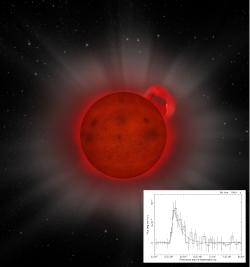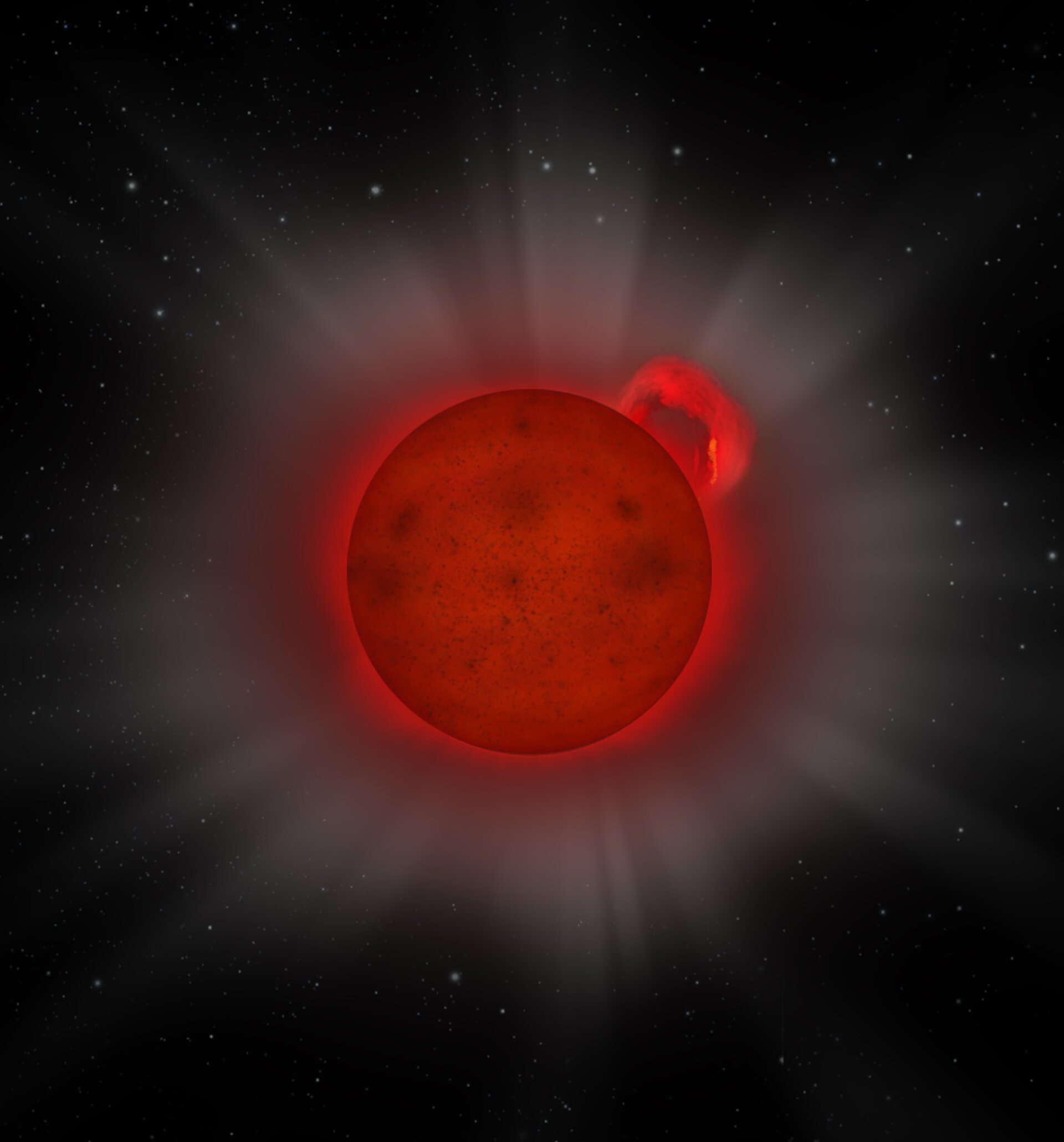Page 1 of 1
HEAPOW: The Dwarf that Roared (2021 Dec 06)
Posted: Mon Dec 06, 2021 6:20 pm
by bystander
 HEAPOW: The Dwarf that Roared (2021 Dec 06)
HEAPOW: The Dwarf that Roared (2021 Dec 06)
Stars are superheated
plasmas, balls of gas so hot electrons are stripped from their atomic nuclei. Gravity causes pressure and temperature to increase from the star's surface to the center, and the inward increase in temperature and pressure can cause hot plasma inside the star to rise, move outward, cool off, then sink back down, a
convective motion similar to the boiling of hot water in a pot on your stove. Stars also rotate (and perform other motions), and convective motions of plasma in a rotating star generates electrical currents that produce a global magnetic field (in most stars, anyway; stars with a mass of about eight times the mass of the Sun or more only show measurable magnetic fields in rare circumstances). As stars spin, their magnetic fields get tangled up, and if they get too tangled they can intensify, producing
potentially catastrophic results. Tangled magnetic fields can lead to strong
stellar flares, outbursts of
matter and energy, which can damage any planet that happens to be in the line of fire. In 2008 observations with the
XMM-Newton X-ray observatory discovered a surprisingly strong stellar flare. The most surprising thing about this flare was that it came from a tiny, cool star so non-descript it's known only by its catalogue number, J0331-27. This star is a
brown dwarf, only a bit more massive than the planet Jupiter. Yet somehow it managed to emit a powerful stellar "
superflare" more than ten times as energetic as any flare ever seen from our Sun. The image above is an artistic representation of what a brown dwarf might look like, with a magnetically-supported loop over a magnetically-active region of the star's surface. The inset shows the increase in X-rays from the star seen by XMM-Newton. Why and how this happened is yet to be determined, and we've yet to see similarly strong flares from other similarly small stars. It does lead you to wonder: could
Jupiter ever explode?
ESA: XMM-Newton Reveals Giant Flare from a Tiny Star
Posted: Mon Dec 06, 2021 6:40 pm
by bystander
XMM-Newton Reveals Giant Flare from a Tiny Star
ESA |
Space Science |
Science & Technology | XMM-Newton | 2020 Feb 20
A star of about eight percent the Sun's mass has been caught emitting an enormous 'super flare' of X-rays – a dramatic high-energy eruption that poses a fundamental problem for astronomers, who did not think it possible on stars that small.
The culprit, known by its catalogue number J0331-27, is a kind of star called an L dwarf. This is a star with so little mass that it is only just above the boundary of actually being a star. If it had any less mass, it would not possess the internal conditions necessary to generate its own energy.
Astronomers spotted the enormous X-ray flare in data recorded on 5 July 2008 by the European Photon Imaging Camera (EPIC) onboard ESA's XMM-Newton X-ray observatory. In a matter of minutes, the tiny star released more than ten times more energy of even the most intense flares suffered by the Sun.
Flares are released when the magnetic field in a star's atmosphere becomes unstable and collapses into a simpler configuration. In the process, it releases a large proportion of the energy that has been stored in it.
This explosive release of energy creates a sudden brightening – the flare – and this is where the new observations present their biggest puzzle. ...
EXTraS discovery of an X-ray superflare from an L dwarf ~ A. De Luca
et al
Re: HEAPOW: The Dwarf that Roared (2021 Dec 06)
Posted: Tue Dec 07, 2021 6:08 pm
by Ann
A long time ago, possibly back in the eighties, I read in Sky & Telescope (or possibly Astronomy Magazine) about a photographer who had caught an "electric blue light" where there was supposed to be a red dwarf star. The photographer thought that he had photographed a flare star in the act of flaring.
Would a big flare actually change the visible color of the red dwarf? Or would all the extra energy be emitted as X-rays and hard ultraviolet light, leaving the visible orange color of the star unchanged?
Ann
Re: HEAPOW: The Dwarf that Roared (2021 Dec 06)
Posted: Tue Dec 07, 2021 6:35 pm
by neufer
Ann wrote: ↑Tue Dec 07, 2021 6:08 pm
A long time ago, possibly back in the eighties, I read in Sky & Telescope (or possibly Astronomy Magazine) about a photographer who had caught an "electric blue light" where there was supposed to be a red dwarf star. The photographer thought that he had photographed a flare star in the act of flaring.
Would a big flare actually change the visible color of the red dwarf? Or would all the extra energy be emitted as X-rays and hard ultraviolet light, leaving the visible orange color of the star unchanged?
My guess: The extra energy would be emitted as X-rays & ultraviolet light, leaving the visible color of the star unchanged.
 HEAPOW: The Dwarf that Roared (2021 Dec 06)
HEAPOW: The Dwarf that Roared (2021 Dec 06)
